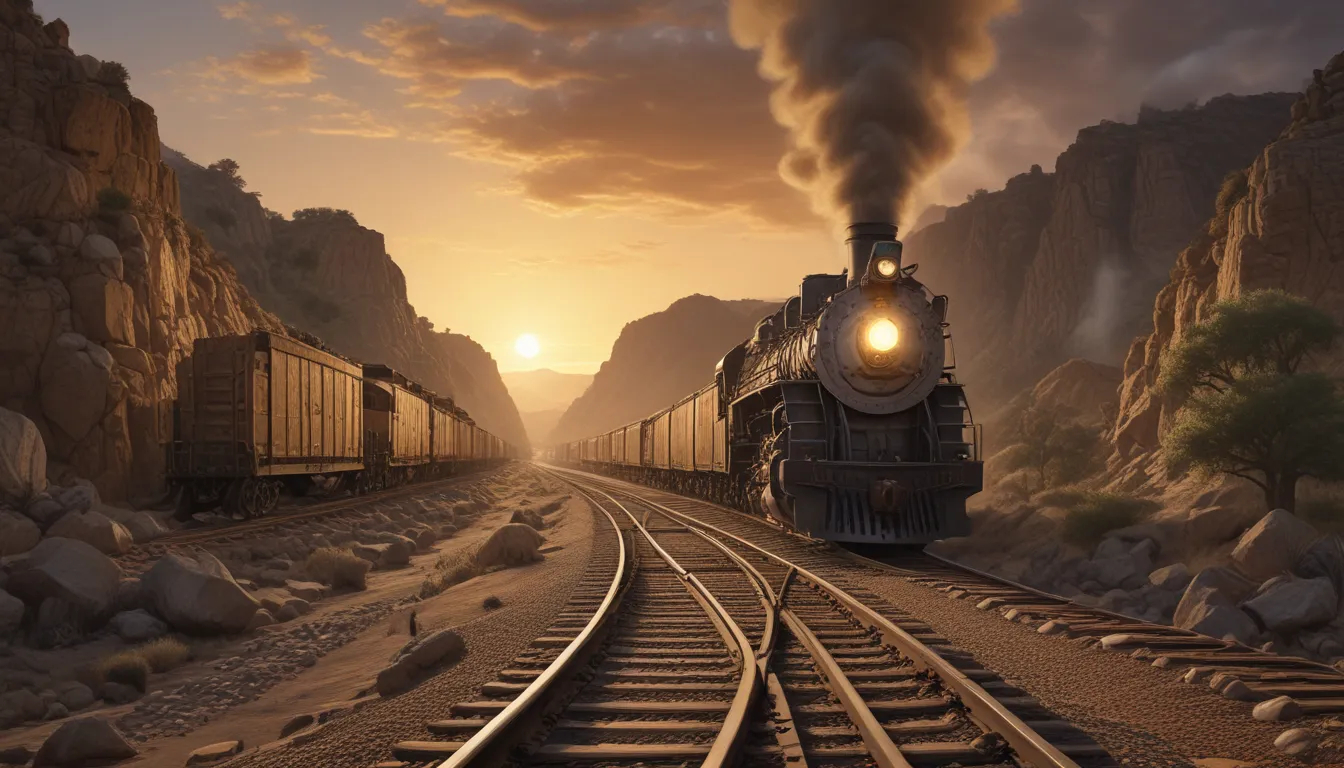The images in our articles may not match the content exactly. They are used to grab your attention, not to show the exact details in the text. The images complement the text but do not replace it.
Have you ever wondered how the vast lands of America were connected before the era of airplanes and highways? The Transcontinental Railroad stands as a monumental achievement, bridging the East and West coast with steel rails and steam power. This engineering marvel not only revolutionized travel but also reshaped the landscape of trade and communication in the United States during the 19th century. Delve into the remarkable stories and fascinating facts behind this historic project to uncover the ingenuity and perseverance that drove its construction.
Connecting the Nation: The Birth of the Transcontinental Railroad
In the mid-19th century, a significant initiative was launched to link the eastern United States with the Pacific coast through the ambitious Transcontinental Railroad project. The construction of this railroad was not merely about laying tracks; it symbolized the unity and progress of a burgeoning nation.
Construction commenced in 1863 amidst the turmoil of the Civil War, following the enactment of the Pacific Railway Act. This legislation marked a pivotal moment in American history, highlighting the government’s determination to create a cohesive and connected country. Two prominent companies, the Central Pacific Railroad starting in Sacramento, California, and the Union Pacific Railroad originating in Omaha, Nebraska, were tasked with the monumental challenge of meeting in Utah to complete the railway.
Overcoming Challenges: The Trials and Triumphs of Building the Railroad
Constructing the Transcontinental Railroad presented significant obstacles and hurdles for the laborers involved. Workers faced harsh conditions, rugged terrains, and the monumental task of laying miles of rail tracks across diverse landscapes.
Diversity was a crucial element of the workforce, with over 10,000 Chinese immigrants contributing to the construction of the Central Pacific Railroad through the treacherous Sierra Nevada mountains. Meanwhile, the Union Pacific employed a diverse group of workers, including Irish immigrants and Civil War veterans. Innovative techniques were developed to overcome natural barriers, such as blasting tunnels through solid granite in the Sierra Nevada, showcasing exceptional skill and bravery. The historic completion of the railroad occurred when the two tracks met at Promontory Summit, Utah, on May 10, 1869, commemorated by the driving of the “Golden Spike.”
Impactful Transformations: The Influence of the Transcontinental Railroad on America
The completion of the Transcontinental Railroad left a lasting impact on the United States, shaping its economic, social, and political landscapes. The railroad acted as a catalyst for economic growth, opening up new markets and facilitating the faster and more affordable transport of goods across the nation.
Additionally, the ease of travel facilitated by the railroad contributed to the rapid movement of people westward, leading to the swift settlement and development of the western United States. Standardized time zones implemented by the railroad companies to streamline train scheduling and enhance safety eventually became a nationwide standard.
Technological Marvels: Innovations Along the Steel Rails
The Transcontinental Railroad not only showcased human determination but also highlighted significant technological advancements of the era. Steam locomotives emerged as the backbone of the railroad, capable of hauling long trains over vast distances, with their design and efficiency continually improving throughout the construction period.
Telegraph lines running alongside the railroad tracks enabled instant communication across the country for the first time, revolutionizing connectivity and information exchange. Durable materials used for railroad spikes and ties ensured the longevity of the tracks, with some portions still in use today.
Cultural Significance: Beyond Economic and Technological Impact
In addition to its economic and technological significance, the Transcontinental Railroad held profound cultural importance for the nation. Symbolizing the physical and symbolic connection between the East and West, the railroad promoted a sense of national unity and progress.
The railroad inspired a wealth of literary works, art pieces, and musical compositions, capturing the nation’s imagination and symbolizing innovation and advancement. Unfortunately, the railroad’s construction had detrimental effects on Native American tribes, leading to the loss of land and traditional ways of life for many.
Enduring Legacy: Celebrating the Transcontinental Railroad’s Impact and Inspirations
Today, the Transcontinental Railroad stands as a celebrated milestone in American history, embodying human ingenuity and resilience. Historical sites such as Promontory Summit in Utah serve as popular tourist destinations, where visitors can immerse themselves in the history and significance of the railroad.
Modern railroads continue to play a vital role in America’s transportation network, carrying passengers and freight across the country. Educational programs and cultural celebrations honor the challenges and triumphs of building the Transcontinental Railroad, inspiring new generations to tackle ambitious endeavors.
The legacy of the Transcontinental Railroad serves as a beacon of innovation and determination, reminding us of the transformative power of human achievement. Despite the digital age, the physical connections and historical significance of the railroad continue to influence and inspire individuals worldwide.
Reflecting on History: The Transcontinental Railroad’s Enduring Impact
As we reflect on the monumental accomplishment of the Transcontinental Railroad, we recognize its profound influence in shaping a nation. Engineers and laborers from diverse backgrounds came together to overcome immense challenges, leaving a lasting mark on America’s cultural and economic landscape.
This iron trail not only expedited travel and trade but also fostered economic growth and influenced settlement patterns. The sacrifices made during its construction serve as a testament to human perseverance and tenacity, embodying a pivotal chapter in American history that remains a source of inspiration.
Exploring Further: Frequently Asked Questions
Q: What exactly was the Transcontinental Railroad?
A: The Transcontinental Railroad was a monumental railway connecting the East and West coasts of the United States, enabling faster and more accessible travel and trade across the vast American landscape.
Q: Who built the Transcontinental Railroad?
A: Thousands of workers, including Chinese immigrants, Irish immigrants, and Civil War veterans, labored to construct the railway, showcasing determination and perseverance in challenging conditions.
Q: How long did it take to complete the Transcontinental Railroad?
A: Construction of the Transcontinental Railroad spanned approximately six years, from the 1860s to its completion in 1869, marked by the driving of the historic “Golden Spike.”
Q: What challenges did workers face while building the railroad?
A: Workers confronted harsh weather, rugged terrains, and constant danger during the construction, overcoming obstacles such as blasting through mountains and bridging canyons to lay down tracks.
Q: How did the Transcontinental Railroad change America?
A: The Transcontinental Railroad revolutionized travel and trade in the United States, spurring economic growth, facilitating westward settlement, and transforming the nation’s cultural and economic landscapes.
Q: Is any part of the original Transcontinental Railroad still in use today?
A: Portions of the original Transcontinental Railroad route are still in use by modern trains, preserving the legacy and impact of this historic railway network.
Q: Can you visit any historical sites related to the Transcontinental Railroad?
A: Yes, several museums and historical sites dedicated to the Transcontinental Railroad offer visitors the opportunity to explore its history and learn about the challenges and innovations of its construction era.
Embracing Quality and Authenticity
At our core, we strive to deliver engaging and trustworthy content that reflects the dedication and diversity of our contributors. Each fact and insight shared on our platform undergoes meticulous review by our dedicated editors to ensure accuracy and reliability. Rest assured that as you journey through history with us, you can trust in the authenticity and quality of the information we provide.






